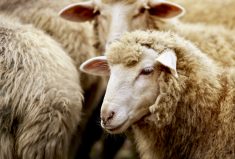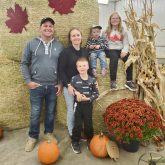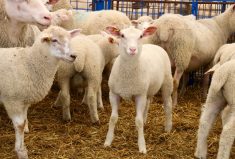Miscommunication, misinterpretation and mistrust are festering splinters in the side of Ontario Sheep Farmers (OSF) and it’s time to treat the wound.
Marc Carere, OSF chair, didn’t mince words during his pre-address to OSF members before the annual general meeting Oct. 23.
A group of sheep farmers in Ontario called the Ontario Lamb Producers Caucus has started up and is signing up members. It has been accepted as a member of the Canadian Sheep Federation, which OSF left four years ago.
“I am frustrated by the distrust in our industry that has led to too many acrimonious and hostile discussions between different parts of our provincial sheep family,” Carere said.
Read Also

BinSentry sensors reduce feed-bin outages
BinSentry sensors mean fewer feed bin outages and more efficient deliver for feed mills.
Early in the pandemic, Carere said he was struck by the sheep industry’s good fortune. While the beef and pork industries were dealing with capacity issues and the fruit and vegetable market with labour challenges, the sheep industry was capitalizing on its nimble growth from a cottage industry to a more professional entity.
“We can shape it (the industry) now and that’s what frustrates me,” said Carere. “Instead of us all pulling in the same direction, we’re pulling at each other. That’s just not good.”
Why it matters: Numerous groups representing one commodity results in duplication and a lack of unified voice to government, consumers and processors.
To that end, Carere is dedicated to increasing communication at the district level to deal with misinformation and message misinterpretation with increased transparency as well as gathering grassroots input on member needs.
Carere said COVID-19 has hindered the opportunity for ‘eye-to-eye’ conversations with members, but he says he’s determined to find a way to rebuild trust and harmony within the organization.
“Being part of a board, or any organization you don’t always agree, and you shouldn’t always agree because there’s got to be differing opinions,” he said. “What you should be able to do is respect the opinion or position that’s been taken if the position is that of the majority. Then you should respect that and move on.”
Carere also announced his intention to reach out to the Canadian Sheep Federation (CSF) and initiate conversations on how to bring the two entities together in a mutually beneficial way.
This endeavour may be more daunting than rebuilding trust internally.
Efforts to unite the OSF and CSF will be unsuccessful unless all members understand each others’ motivations and discover whether they share the same goals.
The CSF took umbrage when the OSF stepped away from the national table four years ago to join the National Sheep Network (NSN) along with Alberta and Quebec.
“We have to make sure all parties are even interested in having those levels of discussion, honest, open, frank and future-looking conversations,” Carere said. “That’s our first step.”
Issues remain to be sorted out at national level
Allan Ribbink, CSF chair and OSF member, said obviously having the provincial organization sitting at the national table would provide a stronger voice for all. However, the federation needs to know why the OSF left in the first place so those issues can be resolved.
The issue is a serious one, which is why Ribbink said he invited the OSF to appear at the CSF board meeting Oct. 25. to the OSF inviting them to appear in front of the board.
In his invitation, he said the federation doesn’t solicit members or pitch to organizations to help gain a membership.
“They want us to go to them and show them a value in a membership in the CSF,” said Ribbink. “There’s value in being and having a voice in the organization that is mandated to oversee the Canadian sheep industry.
“I don’t think anyone has to go to them and explain why they would want to be a part of that.”
Instead, the CSF letter encouraged the OSF to meet with the board and outline the value the provincial organization would bring to the table along with the methods they would employ to rebuild the trust broken when they left.
“I think it’s going to be a challenge to get things fixed when the people that were involved in the betrayal in the first place are involved (in fixing it),” Ribbink said.
The CSF has moved the ball forward considerably in the last two years with Agri-Ledger, a QR-based program allowing meat to be traced from the farmer to the plate and the creation of the Global Sheep Initiative.
“Our board, at some point, will need to know that we’re not inviting more discord because we’ve managed to get an awful lot of things done in the last two years,” he said. “Quite frankly we’re on a roll. So, why would we invite people in that only serve to try and tear things apart?”
When asked what would happen to the four organizations representing various aspects of the Ontario sheep industry currently sitting at the table if OSF re-joined, Ribbink suggested a merger of sorts would ensue.
“I would hope if that was the case, the Ontario Lamb Producers Caucus (OLPC) could kind of merge (with OSF) and become one entity,” he said. “What I see happening as time goes by is there’s probably going to be more and more OLPC members on the OSMA (OSF) board so that would be a merger of sorts.”
Ribbink went on to say the OLPC is an idea much like the National Sheep Network, not an incorporated organization and the invitation to meet with the board extends to Ontario, Alberta and Quebec.
However, in Ribbink’s letter to Carere inviting the OSF to meet with the board, a caveat to the invite clearly states the NSN would need to be dismantled as a show of intention before the CSF would proceed further with Ontario.
That letter, along with the OSF correspondence on Oct. 30, was released to the provincial membership in order to increase transparency, said Carere.
Carere said the other members of the National Sheep Network are aware he is reaching out to the CSF on behalf of the OSF but there is no no coordinated effort to bring the two national organizations together.
“My intent was if we could make a breakthrough here, we could help present that breakthrough to our friends at the NSN,” Carere said.
Carere’s vision is to open communication with people who want to look to the future and discuss how best to get there and capitalize on the industry’s potential.
“I want to give it (reconciliation) the widest berth possible for success in having those positive conversations,” said Carere. “It’s complete sincerity, no hidden agenda. The objective is to utilize the resources we have in our industry and the potential we have to the best possible outcomes.”















